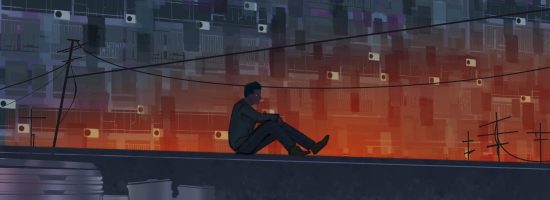search the site
Japanese Anime: A Genesis Art in Reality

Ngo ka Him Kenneth, The Hong Kong Polytechnic University
This article explores how anime’s unique blend of art is spreading across the entertainment universe like cosmic rays. Give it a read and be swept up by the wave.
Japanese Anime: A Genesis Art in Reality
With a big bang, anime’s unique blend of art is taking over the world.
By Ngo Ka Him Kenneth
From out of nowhere, a blood-red laser beam explodes violently into an enemy reaper to save an ally from certain destruction. Then, amid the intensive music, thundering drumbeats and trusted brothers in arms, the main character appears on the hectic battlefield and blazes his path of carnage. The battle is won, and a legend is born.
This famous anime scene comes from Gundam 00 and appeals to every young blood and adult, especially me. What aspects cause it to be that outstanding? The handsomeness of characters? A super heroic arrival? Indeed, these peripheral elements contribute. Yet, the foremost reasons lie in the background of this scene. Like hidden traps, we notice them the least, but they are actually the most essential elements to elevate Japanese animation to supremacy among similar genres: the stories, plots, visual effects, background music and voice acting. These are the decisive components to allow a scene to become profoundly memorable.
The story is the skeleton of anime. If it is not creative or interesting, it won’t get a second glance. This is because every audience enjoys surprises. If the story is too ordinary or realistic or predictable, just like our daily lives, we yawn in boredom. So boring! Thus, great writers utilize one of the key advantages of the anime genre, its semi-realism. Blending surreal elements into realistic characters or events always enriches the story. This mixture creates a brand-new worldview that draws everyone into its unique depths.
An example of great storytelling is “Suzume,” which is a recent anime movie that is ubiquitous worldwide owing to its story. This movie focuses on Japanese earthquakes (the realistic part) and how the main characters hinder the start of the earthquake by closing the “doors” in different districts (the unrealistic part). The realism of earthquakes in places like Tokyo and Kandai not only resonates with the Japanese but also with audiences everywhere. “Suzume” has grossed over $320 million USD globally.
Still, appealing stories alone are not enough to create memorable anime. Plots are the joints that connect the bones together. The relationship of the story and plot is like that of twins, they are inextricably linked. Anime, unlike cartoons, has lengthy and complex stories, which often require a serial approach. Thus, a comprehensive plot is needed to connect all the components; not only the flow of events but also the character arches. This depth of design allows the story to unfold smoothly and spring uncountable surprises that keep us hooked in anticipation of what might lie in wait behind the next bend.
The plot of “Attack on Titan” is legendary among fans. All events are tightly packed, and the author utilizes the skill of foreshadowing to develop a flowing story. Thanks to this impressive structure, the world shows a huge sign of respect by discussing the plots on social media.
In addition to an engaging story and well-developed plot, visual effects and smooth actions are indispensable for excellence in this art form. Anime is different from a novel, which expresses the story with mere mortal words. Anime, however, builds on its use of words with graphics or visual effects to elevate the story to a whole new level. Utilizing the skill of composition (like photography) to illustrate gorgeous vistas and fruitful animation with a variety of colouration creates next-level artistry. Typically, scenic views and breathtaking fights are a savoury cup of tea for most audiences (count me in). Being as pretty as peaches, you can’t tear your eyes away from them; you are spellbound.
If visual effects provide optical joy, background music and voice acting provide auditory entertainment (the parts I like the most). A soundtrack is like the nerve system and organs of anime: its pulsing signals touch the heart and evoke the pathos – often subconsciously – to match the scene. And we cannot exclude the voice acting element, the soul of anime. Those voice actors perform all the feelings of their characters through tones and pace ranging from a long barbaric scream to a short quiet gasp. Their performances integrate and elevate the visuals to a superior level. And when a scene seamlessly merges the gorgeous vocals and flawless background music, it creates a soul-stirring moment that allows the audience to memorize it profoundly (Demon Slayer is a wonderful example).
Largely because of these ‘behind the scenes’ elements, anime has created a unique art form and accompanying culture that is spreading like a fuel-injected coronavirus. Cosplay, for example, is an obvious offshoot. The Anime Expo, an event that is held every year, is flocked to by cosplayers worldwide. It is there that they imitate their beloved characters’ outfits or personalities by designing their own clothes. Their energetic sincerity expresses their love of Japanese animation. Moreover, you can buy related products if the boldness of cosplay is not your thing. Akihabara, aka Anime Heaven, is also a place in Japan where anime products are sold. The fans’ religious-like pilgrimage there is testimony to how influential anime is in the world.
Perhaps one of the best illustrations of the passion people have for anime can be found with Liu Wei, an executive of a company named miHoYo. He spares no effort to support Japanese animation by raising funds for his own anime game company even though he was being teased because of his ‘naïve’ ideas. Nevertheless, his perseverance broke this plight and led him to success. Genshin Impact is an illustrious game from his own hands. It perfects all those decisive components, especially background music and graphics (see a review). The outstanding performance has caught the world’s attention and has become a ubiquitous topic among fans.
I know this short article has only given you a toe-in-the-water introduction to one of Japan’s best exports, but I will leave you with a question. If you aren’t a fan of anime by now, what are you waiting for?
Jump into the ever-expanding river and be immersed in this genesis art that is truly genius.

About the Author
Ngo ka Him Kenneth, a Hong Kong resident, is in year two of PolyU’s Land Surveying and Geo-informatics (LSGI) major. Since his leisure time activities are ‘studying, studying, and studying,’ we are especially grateful that he has taken time away from his busy schedule to share his writing. However, due to the topic of his article, we suspect that Kenneth manages to squeeze in some video games and anime. Perhaps his studiously grounded but futuristic approach to university life will serve him well when he becomes a land surveyor and engages in future Hong Kong construction projects. We look forward to seeing some anime-infused buildings on the skyline.
Author’s Reflection
As part of the requirements for my Advanced English Reading and Writing Skills course, I choose to author an opinion article about Japanese anime. This provided me with a good chance to think more deeply about a topic of interest and explain how anime influences the world intensively. When I started writing this article, I hit a wall. I was confused about organising my paragraphs to express the specific ideas and the language with which I wanted to beautify my thoughts. Thus, I wrote an outline to organise my tangled neurons into somewhat coherent chunks and eventually started my first draft. After meeting my professor in the consultation section, he delivered many constructive comments, especially regarding my persuasive tone. After many spins through the editing cycle, I finally created something that I was satisfied with.
After my assignment submission and the end of the course, I heard that there was potential for my article to be published in Inscribe. I jumped at this additional opportunity for me to build further upon my English writing skills and spread the good word about anime further. In my perspective, the editors really helped me to refine my article into something I was very proud of.
I hope this article can change your opinions toward Japanese anime. Please remember that it’s not a genre for ‘nerds’ to watch but is a genesis-type art created by geniuses for everyone to appreciate. Jump in!














